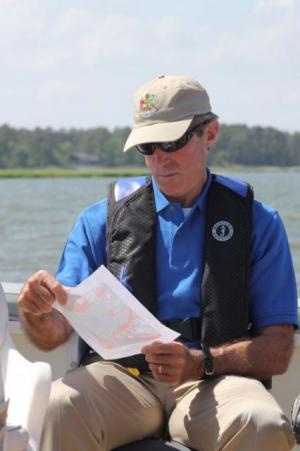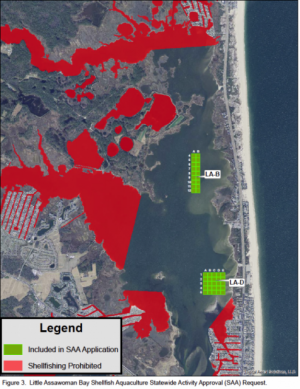Delaware moving forward with first aquaculture program
State officials recently announced approval of a streamlined permitting process for the state's first commercial aquaculture program, but it will still be a while before Delawareans see locally harvested shellfish on the menu.
The Department of Natural Resources and Environmental Control proposed a statewide activity approval process for aquaculture in spring 2016 – three years after commercial shellfish aquaculture in the Inland Bays was signed into law. Officials announced Dec. 22 that the streamlined permitting process, which will simplify how acreage in the Inland Bays will be leased, had been officially adopted.
But fishermen like Steve Friend, who has invested more than $70,000 in equipment in anticipation of the state's first aquaculture program, still have to wait a while longer before they can plant their first oyster seed in the bays.
“I'm tired of getting aggravated and worrying about it and wondering if I just took all this money and blew it,” Friend said. “Should I move down to Virginia or Maryland so I can grow some oysters and clams?”
Friend said he will wait to make that final decision in hopes that Delaware can get the program up and running in 2017. Even if leases are issued in the coming months, it may take years for aquaculturists like Friend to see a return on their investment.
After oyster larvae, or spat, are planted, it takes about three years for them to grow large enough to harvest and put on the half shell.
And, Friend said, it's still unclear where he will get his oyster seed, insurance coverage or the required bonding to get his business going. Those details of the program have not been hashed out, he said.
“DNREC still has a long ways to go because of dragging their feet,” Friend said. “All of this stuff should have been done.”
The state's streamlined permitting process only covers 343 of the 442 acres originally approved for shellfish harvesting in the state's 2014 regulations. Aquaculturists may farm outside of the 343 acres identified in Indian River, Rehoboth and Little Assawoman bays, but will be required to obtain individual permits for those areas.
“Approval of this process addresses concerns we have heard from waterfront property owners around the Inland Bays, and still allows certainty for small business interests who wish to pursue growing oysters and clams in the Inland Bays,” DNREC Secretary David Small said in a press release.
DNREC officials also announced Dec. 20 that only hard clams – not oysters – will be harvested in the 43 acres identified for commercial aquaculture in Little Assawoman Bay.
“It is hard to see so much acreage removed from the expedited permitting process,” said Chris Bason, executive director of the Delaware Center for the Inland Bays, which played an integral role in guiding the development of regulations and farming areas. “New growers need a variety of locations and conditions in the bays to increase their chances of success.”
Bason said one acre of an oyster farm can filter more than 15 million gallons of water a day, which can benefit water quality and aquatic habitat.
“Overall, this is a step in the right direction, and I encourage the incoming governor to find new ways to support this industry that will be so beneficial to the water and the people of the area,” Bason said.
Eliminating nearly a quarter of the plots in the shellfish aquaculture development areas, or SADAs, from the streamlined permitting process was driven in part by opposition from nearby residents who complained about the proposed aquaculture program and sites. Those residents have argued aquaculture gear and plot markers would be unsightly and could interfere with navigation and recreation in some areas of the Inland Bays.
Diane Maddex, spokesperson for the Coalition for Little Assawoman Bay, said in a press release that some of those concerns still remain.
“Installation of up to 172 6-inch-wide PVC marker poles extending at least 5 feet above the water surface remains a possibility and a danger,” she said. “Kayakers, paddleboarders and novice sailors can't be expected to maneuver safely around obstacles like these.”
The state's regulations call for each 1-acre plot to be marked by PVC pipes, a regulatory requirement that has been heavily criticized by nearby residents as well as aquaculture experts and future shellfish farmers. DNREC officials have said they will review that aspect of the program in the future.
Maddex said the coalition also wants to see acreage in Little Assawoman Bay permanently reduced. Initially, the state proposed 118 acres for harvesting in the bay. While the statewide activity approval process only includes 43 of those acres, aquaculturists could apply for individual permits in other areas.
However, the lease process will not begin until the U.S. Army Corps of Engineers issues its new, 5-year nationwide permits governing commercial aquaculture in spring 2017. Once the Corps releases those permits, which will streamline the permitting process at the federal level, the state's Wetlands and Subaqueous Lands section can begin facilitating permits through the statewide approval process.
The first leases would be determined by a lottery and would be annually renewable for 15 years. The application fee for a 1-acre aquaculture lease held by a Delawarean is $300, with annual renewal fees for Delaware residents costing an additional $100 per acre. The annual renewal fee for nonresidents is $1,000 per acre. Farmers will be able to lease 1-5 acres for oyster harvesting in Rehoboth and Indian River bays, and an additional 1-5 acres to harvest hard clams in Little Assawoman Bay.
For more information, go to www.dnrec.delaware.gov/fw/Fisheries/Pages/ShellfishAquaculture.aspx.
























































